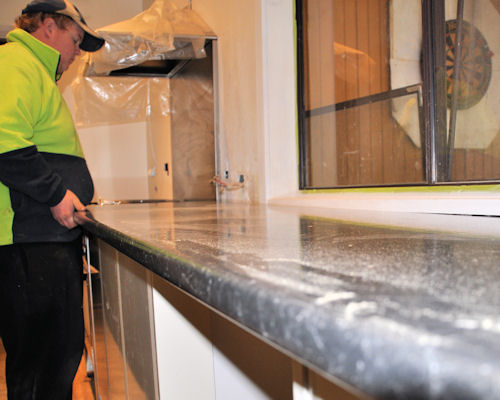Fitting bench tops
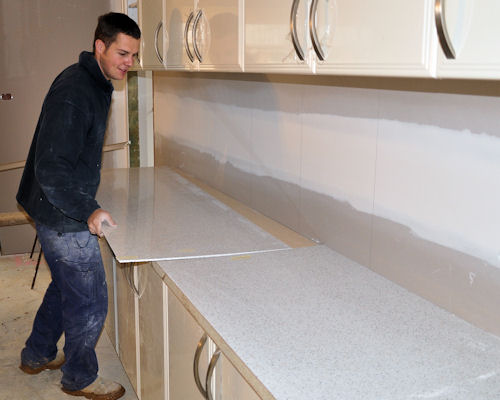 Audio for slide 1 (mp3 |6|KB)
Audio for slide 1 (mp3 |6|KB)
Once the floor units have been fixed to the kickboard and wall, the bench top can be fitted.
Bench tops are generally prefabricated in pieces as large as possible, while still being manageable for transporting and putting into position.
This helps to create a smooth finish with the minimum number of joins.

Bench tops are generally prefabricated in pieces as large as possible, while still being manageable for transporting and putting into position.
This helps to create a smooth finish with the minimum number of joins.

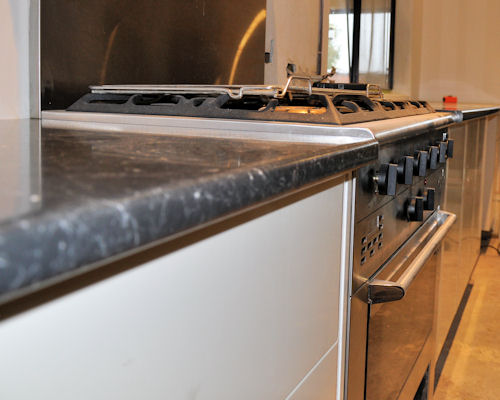 Audio for slide 2 (mp3 |6|KB)
Audio for slide 2 (mp3 |6|KB)
There are many different types of materials used in bench tops.
The most common tops are made from moisture resistant particleboard or MDF (medium density fibreboard) finished with laminated plastic or melamine.
More expensive tops use solid timber, stainless steel, stone such as granite or marble, 'engineered' stone such as CaesarStone, and synthetic products such as Corian.

The most common tops are made from moisture resistant particleboard or MDF (medium density fibreboard) finished with laminated plastic or melamine.
More expensive tops use solid timber, stainless steel, stone such as granite or marble, 'engineered' stone such as CaesarStone, and synthetic products such as Corian.

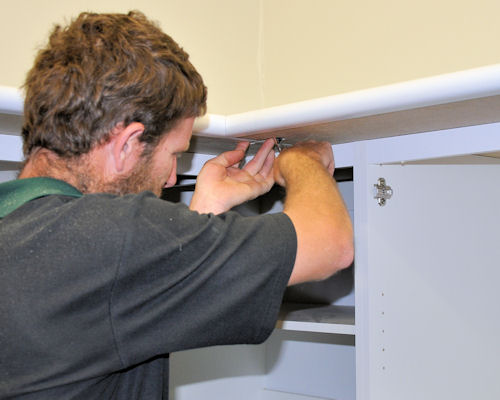 Audio for slide 3 (mp3 |6|KB)
Audio for slide 3 (mp3 |6|KB)
If the top is laminated particleboard or MDF, it's likely that your own company will have prefabricated it and you'll install it.
If it is a more specialised product, the manufacturer may send their own person out to do the on-site installation.
Set out below is a typical installation procedure for a laminated particleboard bench top.

If it is a more specialised product, the manufacturer may send their own person out to do the on-site installation.
Set out below is a typical installation procedure for a laminated particleboard bench top.

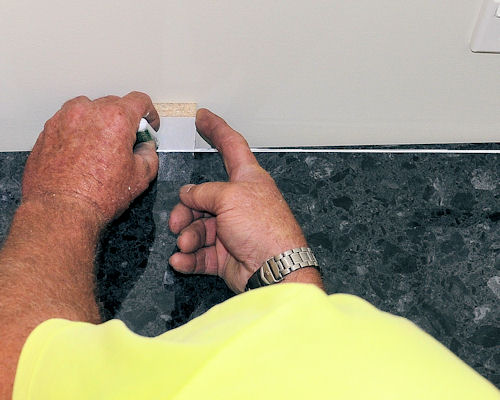 Audio for slide 5 (mp3 |6|KB)
Audio for slide 5 (mp3 |6|KB)
If the top needs to be cut back or scribed to the wall, mark the top and re-cut or shape it using the appropriate tools.
For more details on this process, see the lesson: 'Panels and bench tops' from the unit Adjusting cabinets on-site.

For more details on this process, see the lesson: 'Panels and bench tops' from the unit Adjusting cabinets on-site.

 Audio for slide 6 (mp3 |6|KB)
Audio for slide 6 (mp3 |6|KB)
2. Check that the finished bench top has a gap of no more than 2 mm at any point to the wall.
Fix it to the cabinets with screws, working from the underside of the cabinets' top rails.
Be careful that the screws are long enough to provide a sound fixing into the bench top, but are short enough to avoid going right through.
Never use glue to fasten the bench top to the cabinets.
Glue doesn't allow for any movement that might occur due to variations in humidity or changes in temperature.

Fix it to the cabinets with screws, working from the underside of the cabinets' top rails.
Be careful that the screws are long enough to provide a sound fixing into the bench top, but are short enough to avoid going right through.
Never use glue to fasten the bench top to the cabinets.
Glue doesn't allow for any movement that might occur due to variations in humidity or changes in temperature.

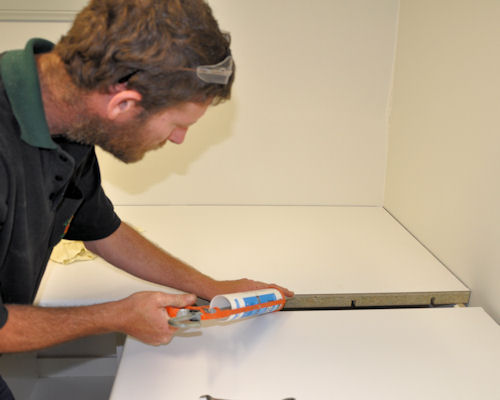 Audio for slide 7 (mp3 |6|KB)
Audio for slide 7 (mp3 |6|KB)
3. If the wall is already finished or only needs to be painted, put a bead of silicone-based sealant along the joint.
However, if you know that the wall is going to be tiled later or fitted with a splashback panel, you may be able to leave the gap as it is.
Where there are joins in the bench top itself, use a silicone-based adhesive to secure the joint and provide a water-tight seal.
Then tighten up the screws or bolts used to draw to two pieces together.

However, if you know that the wall is going to be tiled later or fitted with a splashback panel, you may be able to leave the gap as it is.
Where there are joins in the bench top itself, use a silicone-based adhesive to secure the joint and provide a water-tight seal.
Then tighten up the screws or bolts used to draw to two pieces together.



Learning activity
Audio 8 (mp3 |6|KB)What types of bench tops do you (or your company) install as part of your on-site fit-outs? What other bench tops does your company offer clients that require installation from a specialist contractor?
For each bench top you list, write a brief description of its advantages and disadvantages. Share your answers with your trainer and other learners in your group. You might like to include digital photos of any bench tops you're able to photograph, either in the workshop or installed in a client's home.

 Go to Finishing to the wall
Go to Finishing to the wall